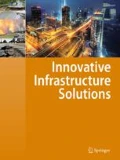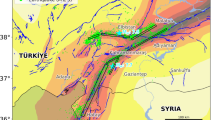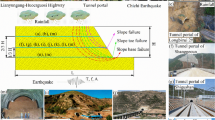Abstract
The effects of vertical seismic excitations have a considerable destructive potential for long-span structures, particularly for near-field earthquakes. A quantification analysis is carried out in this paper to describe the response of a 25-m long trapezoidal truss frame with a height of 9 m under Vertical Ground Motion (VGM) with the help of eight near-field seismic excitations. Linear analysis of earthquake load combinations, including VGMs, has been conducted. The VGMs are leading the design of the long-span roof truss rather than the wind load. The time history analysis is therefore performed for horizontal ground acceleration and horizontal plus vertical acceleration using SAP 2000. For this analysis, eight near-field earthquake ground motion records consisting of four with pulse and four without pulse from the PEER NGA database, consistent with the ATC-63 requirements, are selected. The response of the structure is observed in different parameters such as the axial force of the column, the vertical displacement of the ends of the roof truss and the edge of the truss, the axial load of the bottom truss, and the base moment. This work quantifies the effect of vertical seismic excitations on a long-span industrial trapezoidal truss and demonstrates the need for a time history study of the VGM component.

















Similar content being viewed by others
References
Shrestha B (2009) Vertical ground motions and its effect on engineering structures: a state-of-the-art-review. Int Semin Hazard Manag Sustain Develop Kathmandu Nepal. https://doi.org/10.13140/2.1.2863.6165
ATC 63 (2007) Recommended methodology for quantification of building system performance and response parameters - 75% interim draft report. Redwood: Applied Technology Council
Hosseini M, Nezamabadi MF (2004) A study on the effect of vertical ground acceleration on the seismic response of steel buildings. Proceedings of 13th World Conference on Earthquake Engineering, Vancouver, Canada, No. 2377
Sadeghvaziri MA, Foutch DA (1991) Dynamic behaviour of R/C highway bridges under the combined effect of horizontal and vertical earthquake motions. J Earthq Eng Struct Dynam 20:535–549
Hosseini M, Tavoosi TS (1999) Seismic response of a multi-span highway R/C bridge to simultaneous horizontal and vertical ground motion. Proceedings of the 39th Scientific Week of Syria, Damascus, Syria
Kim SJ, Holub CJ, Elnashai AS (2011) Analytical assessment of the effect of vertical earthquake motion on RC bridge piers. ASCE J Struct Eng 137:252–260
Rahai A, Arezoumandi M (2008) Effect of vertical motion of earthquake on RC bridge pier. The 14th World Conference on Earthquake Engineering, Beijing
Hatamizadeh MH, Nikghalb AA, Kazem H (2015) The effect of vertical component of earthquake on the long span frames. J Novel Appl Sci 4:963–966
Xiang Y, Luo Y, Huang Q, Shen Z (2017) Vertical ductility demand and residual displacement of roof-type steel structures subjected to vertical earthquake ground motions. Soil Dynam Earthq Eng. https://doi.org/10.1016/j.engstruct.2017.06.043
Ahiwale DD, Khartode RR (2020) Evaluation seismic response for soft storey building retrofitted with infill, steel bracing and shear wall. J Struct Technol 5:1–13
Ahiwale DD, Khartode RR, Raut KV (2020) Seismic response for RC frames on sloping ground using pushover analysis. J Struct Eng Manag 7:36–46
Ahiwale D, Dewarde A, Narule G, Khartode R (2020) Seismic response assessment of steel frame step-back building for different fluid viscous damper. J Seybold Rep 15:1969–1983
Morkhade SG, Gupta LM (2015) Experimental study and rotational capacity of steel beams with web openings. Int J Civ Struct Eng 6:58–69
Morkhade SG, Baswaraj SM, Nayak CB (2019) Comparative study of effect of web openings on the strength capacities of steel beam with trapezoidally corrugated web. Asian J Civ Eng 20:1089–1099
Morkhade SG, Kshirsagar M, Dange R, Patil A (2019) Analytical study of effect of web opening on flexural behaviour of hybrid beams. Asian J Civ Eng 20:537–547
Morkhade SG, Lokhande RS, Gund UD, Divate AB, Deosarkar SS, Chavan MU (2020) Structural behaviour of castellated steel beams with reinforced web openings. Asian J Civ Eng 21:1067–1078
Raut KV, Morkhade SG, Khartode RR, Ahiwale DD (2020) Experimental study on flexural behavior of light steel hollow flange beam with various stiffening arrangements. Innov Infrastruct Sol. https://doi.org/10.1007/s41062-020-00345-4
Kaveh A, Mahdavi VR (2014) Colliding bodies optimization method for optimum design of truss structures with continuous variables. Adv Eng Softw. https://doi.org/10.1016/j.advengsoft.2014.01.002
Kaveh A, Talatahari S (2009) A particle swarm ant colony optimization for truss structures with discrete variable. J Constr Steel Res 65:1558–1568
Kaveh A, Talatahari S (2009) Size optimization of space trusses using big bang–big crunch algorithm. Comput Struct. https://doi.org/10.1016/j.compstruc.2009.04.011
Kaveh A, Talatahari S (2010) A discrete big bang–big crunch algorithm for optimal design of skeletal structures. Asian J Civ Eng 11:103–122
Ruiz D, Sarria A (2004) Response of large span steel frames subjected to horizontal and vertical seismic motions. Proceedings of the 13th World Conference on Earthquake Engineering, Vancouver, B. C. Canada
Taniguchi Y (2013) Ultimate seismic resistance capacity for long span lattice structures under vertical ground motions. J Struct. https://doi.org/10.1155/2013/679859
Zhang Y, Lan T (1984) Analysis of space frames under vertical earthquake loads. IABSE Congress Report Twelfth Congress, Vancouver, BC. https://doi.org/10.5169/seals-12117
IS 1893 Part-1 (2016) Criteria for earthquake resistant design of structures. General provision and buildings, Bureau of Indian Standards, New Delhi
IS 1893 Part-4 (2015) Criteria for earthquake resistant design of structures. Industrial structures including stack-like structures, Bureau of Indian Standards, New Delhi
IS 875 Part-3 (1987) Code of practice for design loads (other than earthquake) for buildings and structures: wind loads. Bureau of Indian Standards, New Delhi
IS 800 (2007) Code of practice for general construction in steel. Bureau of Indian Standards, New Delhi
Chopra AK (1995) Dynamics of structures: theory and applications to earthquake engineering. Prentice Hall, University of California at Berkeley
CSI version 19 (2018) Integrated finite element analysis and design of structures basic analysis reference manual. Computers and Structures Inc, Berkeley
Bentley (2011) STAAD Pro & STAAD foundation software. http://www.staadpro.com STAAD.ProV8i
ASCE/SEI 7–05 (2006) Minimum design loads for buildings and other structures. American Society of Civil Engineers
Najafi LH, Tehranizadeh M (2015) Ground motion selection and scaling in practice. Period Polytech Civ Eng 59:233–248
Pacific Earthquake Engineering Research Center (2005) PEER Ground Motion https://peer.berkeley.edu/nga. Accessed 20 December 2019
ASCE/SEI 41–13 (2013) Seismic evaluation and upgrade of existing buildings. Reston: American Society of Civil Engineers
Author information
Authors and Affiliations
Corresponding author
Ethics declarations
Conflict of interest
The corresponding authors claim on behalf of all authors that no conflict of interest exists.
Rights and permissions
About this article
Cite this article
Ahiwale, D., Shaha, P., Palaniyandi, K. et al. Quantification study for roof truss subjected to near-fault ground motions. Innov. Infrastruct. Solut. 6, 118 (2021). https://doi.org/10.1007/s41062-021-00478-0
Received:
Accepted:
Published:
DOI: https://doi.org/10.1007/s41062-021-00478-0




